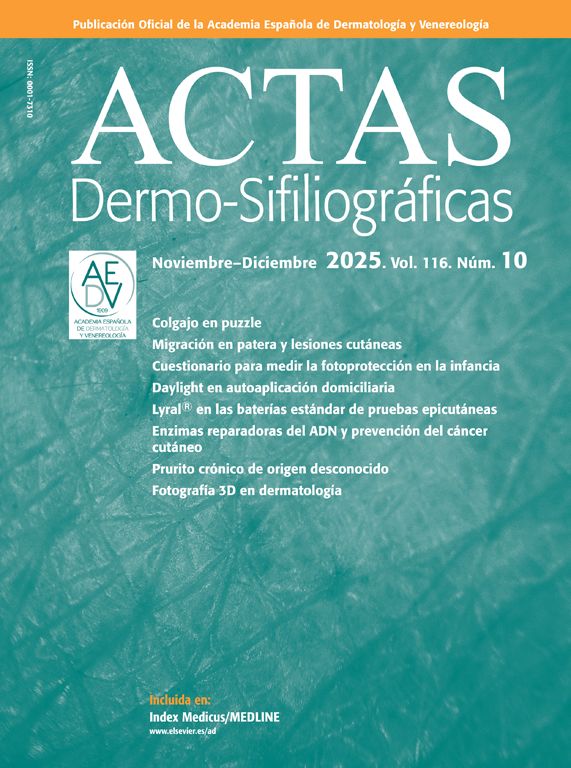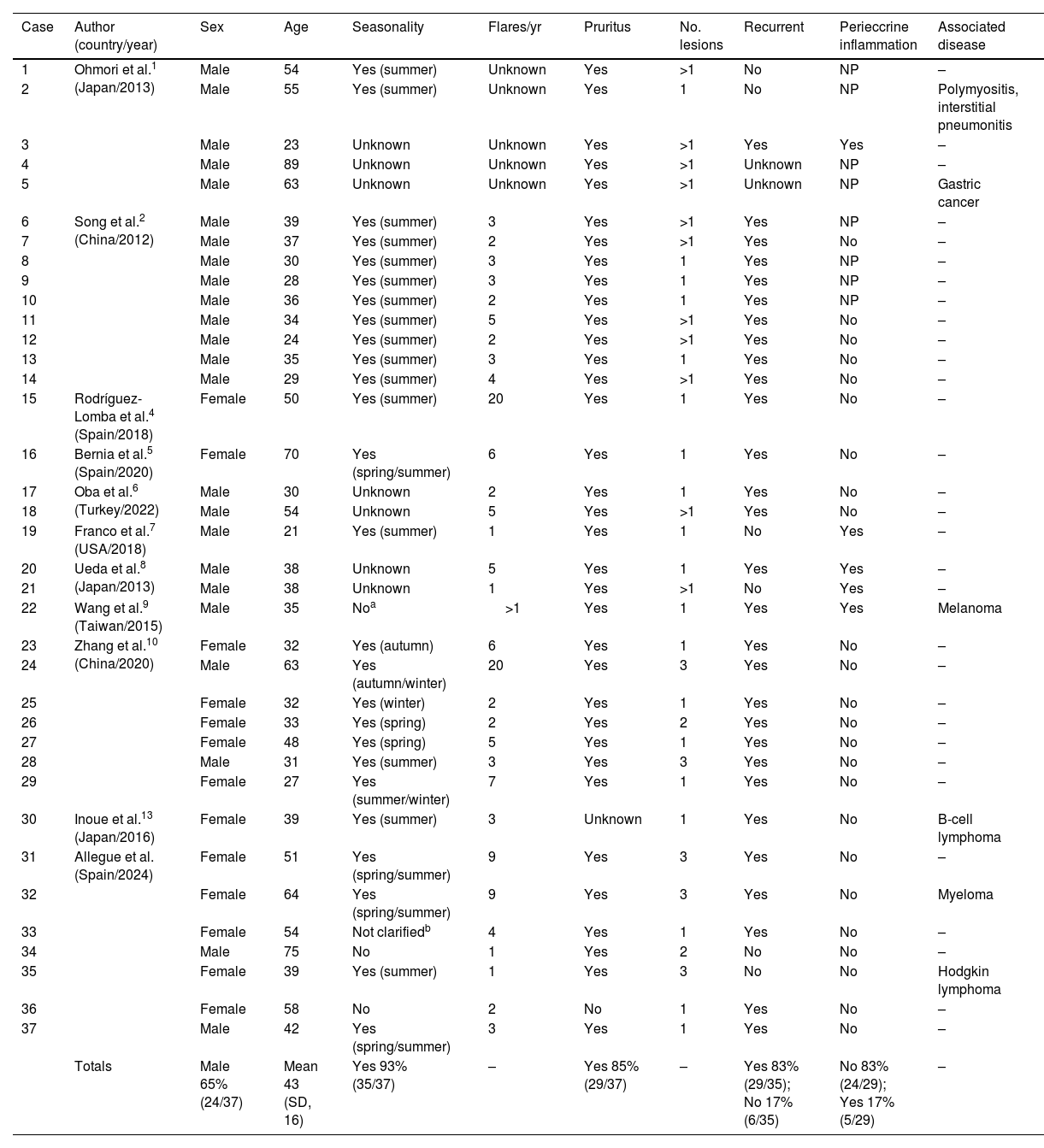Erythema papulatum centrifugum is a rare condition marked by a centrifugally growing border dotted with small papules and a relapsing course, often worse in spring and summer. There are not any specific diagnostic tests to confirm it. This study analyzes the clinical characteristics of seven cases, representing the largest series of non-oriental patients to date. Our findings confirm the pruritic and seasonally relapsing nature of this condition. Lesions are typically few, primarily located on the trunk, and generally exceed 5cm in diameter. Interestingly, in one patient, two outbreaks correlated temporally with the COVID-19 vaccine. In two other cases, the condition was linked to hematological malignancies: multiple myeloma and Hodgkin lymphoma. These observations, along with other neoplasm-associated cases reported in the literature, suggest that this entity might function as a paraneoplastic syndrome.
El eritema papuloso centrífugo es un cuadro poco frecuente caracterizado por un borde de crecimiento centrífugo salpicado de pequeñas pápulas y un curso recidivante, con predominio en primavera y verano. No existen pruebas complementarias que certifiquen el diagnóstico. Se analizan las características clínicas de 7 casos que conforman, hasta la fecha, la serie más extensa de pacientes no orientales, confirmando su carácter pruriginoso y recidivante estacional. Las lesiones suelen ser escasas en número, de predominio en tronco, y su diámetro es generalmente superior a 5cm. Como posible papel desencadenante, en uno de nuestros pacientes, 2 de los brotes tuvieron una relación temporal con la vacuna para COVID-19, y en otros 2 casos se relacionó con sendas neoplasias hematológicas: un mieloma múltiple y un linfoma de Hodgkin. Estos y otros casos asociados a neoplasias referidos en la literatura plantean que esta entidad pueda comportarse como un síndrome paraneoplásico.
Papular centrifugal erythema (PCE) is an uncommon condition that presents as a pruritic figurate erythema that enlarges in an annular or semiannular pattern with central clearing and a rim peppered with small erythematous papules. In 2013, Ohmori et al. published the first 5 cases in the Western literature and reviewed 152 cases from the Japanese literature, defining its clinico-epidemiologic features.1 PCE is more frequent in men and predominates in middle age. It usually presents as a single lesion or ≤5 lesions, most often on the abdomen and extremities. In more than half of cases, it is recurrent with a summer predominance. Occasional tumor associations have been reported. Our objective was to describe the characteristics of this entity in our setting.
MethodsWe conducted a cross-sectional observational study with ambispective data collection within the AEDV CLINI-AEDV platform, approved by Hospital Universitario Puerta de Hierro–Majadahonda (Madrid, Spain) Research Ethics Committee for Medicinal Products (Minutes no. 18/2022).
The study population comprised all patients of any age and sex seen by each recruiting dermatologist with a clinical diagnosis of PCE.
Dermatologists were invited to participate through AEDV dissemination channels and national dermatology social networks (February 2024). Participants included all cases with this diagnosis from their centers.
Data were collected in an online case-report form via the REDCap platform.
Demographic, clinical, and epidemiologic variables were recorded, and descriptive statistics were performed.
ResultsSeven PCE cases from 6 dermatologists were included. Demographic, clinical, and epidemiologic data for the patients in the present series (numbered 31–37) and for those reported in the English- and Spanish-language literature are detailed in Table 1. Cases cited by Ohmori from the Japanese literature were not included.
PCE cases: literature review.
| Case | Author (country/year) | Sex | Age | Seasonality | Flares/yr | Pruritus | No. lesions | Recurrent | Perieccrine inflammation | Associated disease |
|---|---|---|---|---|---|---|---|---|---|---|
| 1 | Ohmori et al.1 (Japan/2013) | Male | 54 | Yes (summer) | Unknown | Yes | >1 | No | NP | – |
| 2 | Male | 55 | Yes (summer) | Unknown | Yes | 1 | No | NP | Polymyositis, interstitial pneumonitis | |
| 3 | Male | 23 | Unknown | Unknown | Yes | >1 | Yes | Yes | – | |
| 4 | Male | 89 | Unknown | Unknown | Yes | >1 | Unknown | NP | – | |
| 5 | Male | 63 | Unknown | Unknown | Yes | >1 | Unknown | NP | Gastric cancer | |
| 6 | Song et al.2 (China/2012) | Male | 39 | Yes (summer) | 3 | Yes | >1 | Yes | NP | – |
| 7 | Male | 37 | Yes (summer) | 2 | Yes | >1 | Yes | No | – | |
| 8 | Male | 30 | Yes (summer) | 3 | Yes | 1 | Yes | NP | – | |
| 9 | Male | 28 | Yes (summer) | 3 | Yes | 1 | Yes | NP | – | |
| 10 | Male | 36 | Yes (summer) | 2 | Yes | 1 | Yes | NP | – | |
| 11 | Male | 34 | Yes (summer) | 5 | Yes | >1 | Yes | No | – | |
| 12 | Male | 24 | Yes (summer) | 2 | Yes | >1 | Yes | No | – | |
| 13 | Male | 35 | Yes (summer) | 3 | Yes | 1 | Yes | No | – | |
| 14 | Male | 29 | Yes (summer) | 4 | Yes | >1 | Yes | No | – | |
| 15 | Rodríguez-Lomba et al.4 (Spain/2018) | Female | 50 | Yes (summer) | 20 | Yes | 1 | Yes | No | – |
| 16 | Bernia et al.5 (Spain/2020) | Female | 70 | Yes (spring/summer) | 6 | Yes | 1 | Yes | No | – |
| 17 | Oba et al.6 (Turkey/2022) | Male | 30 | Unknown | 2 | Yes | 1 | Yes | No | – |
| 18 | Male | 54 | Unknown | 5 | Yes | >1 | Yes | No | – | |
| 19 | Franco et al.7 (USA/2018) | Male | 21 | Yes (summer) | 1 | Yes | 1 | No | Yes | – |
| 20 | Ueda et al.8 (Japan/2013) | Male | 38 | Unknown | 5 | Yes | 1 | Yes | Yes | – |
| 21 | Male | 38 | Unknown | 1 | Yes | >1 | No | Yes | – | |
| 22 | Wang et al.9 (Taiwan/2015) | Male | 35 | Noa | >1 | Yes | 1 | Yes | Yes | Melanoma |
| 23 | Zhang et al.10 (China/2020) | Female | 32 | Yes (autumn) | 6 | Yes | 1 | Yes | No | – |
| 24 | Male | 63 | Yes (autumn/winter) | 20 | Yes | 3 | Yes | No | – | |
| 25 | Female | 32 | Yes (winter) | 2 | Yes | 1 | Yes | No | – | |
| 26 | Female | 33 | Yes (spring) | 2 | Yes | 2 | Yes | No | – | |
| 27 | Female | 48 | Yes (spring) | 5 | Yes | 1 | Yes | No | – | |
| 28 | Male | 31 | Yes (summer) | 3 | Yes | 3 | Yes | No | – | |
| 29 | Female | 27 | Yes (summer/winter) | 7 | Yes | 1 | Yes | No | – | |
| 30 | Inoue et al.13 (Japan/2016) | Female | 39 | Yes (summer) | 3 | Unknown | 1 | Yes | No | B-cell lymphoma |
| 31 | Allegue et al. (Spain/2024) | Female | 51 | Yes (spring/summer) | 9 | Yes | 3 | Yes | No | – |
| 32 | Female | 64 | Yes (spring/summer) | 9 | Yes | 3 | Yes | No | Myeloma | |
| 33 | Female | 54 | Not clarifiedb | 4 | Yes | 1 | Yes | No | – | |
| 34 | Male | 75 | No | 1 | Yes | 2 | No | No | – | |
| 35 | Female | 39 | Yes (summer) | 1 | Yes | 3 | No | No | Hodgkin lymphoma | |
| 36 | Female | 58 | No | 2 | No | 1 | Yes | No | – | |
| 37 | Male | 42 | Yes (spring/summer) | 3 | Yes | 1 | Yes | No | – | |
| Totals | Male 65% (24/37) | Mean 43 (SD, 16) | Yes 93% (35/37) | – | Yes 85% (29/37) | – | Yes 83% (29/35); No 17% (6/35) | No 83% (24/29); Yes 17% (5/29) | – |
NP: not performed.
We studied a total of 7 patients (2 men, 5 women) aged 39–75 years. At inclusion, lesion count ranged from 1 to 3. In 4 patients, lesions were annular (at least one complete ring) and in 3 semiannular (Fig. 1). Six patients reported pruritus. Maximum lesion diameter exceeded 5cm in all but one case, with the largest reaching 40cm. The papules peppering the rims were numerous (20–60) and small (2–6mm). The most frequent sites were the abdomen, followed by the back and upper limbs. Five patients had a recurrent course, with spring–summer onset in 4; timing could not be specified in 2. The number of recurrences per patient ranged from 2 to 9, although 2 patients had only a single episode. Each flare lasted 1–6 months and resolved with residual pigmentation in 5 cases.
Large annular plaque occupying the entire abdomen with a rim peppered with papules in patient 32 (a); semiannular plaque with a papular rim on the abdomen in patient 33 (b); extensive annular erythema with papule-studded borders and central pigmentation in patient 34 (c); another plaque on the thigh in patient 34 (d); large plaque with a tendency to central clearing and numerous predominantly peripheral papules in patient 35 (e); semiannular plaque on the breast with an erythematous papular rim in patient 36 (f).
Regarding ancillary testing, no fungal studies were performed; patch testing was run in only 2 cases – negative in case 33 and weakly positive on day 4 to dodecyl gallate and gallate mix with unknown relevance in case 37. Two patients had ANA >1:160; one of them also had low C4, anticentromere antibodies, and antimitochondrial antibodies (M2), and a third had mildly elevated C-reactive protein and low LDH. Six patients underwent biopsy; all showed a perivascular lymphohistiocytic infiltrate (superficial and deep in 3), with occasional eosinophils (4 cases) and neutrophils (3 cases). Three patients exhibited epidermal changes – acanthosis, spongiosis, and exocytosis – but none showed abnormalities of the eccrine sweat glands.
No triggers such as alcohol, spicy foods, sweating, or infections were identified. In case 37, two flares occurred after the administration of 2 Pfizer COVID-19 vaccines. One patient had concomitant diarrhea, one had Hodgkin lymphoma, and another had IgG-kappa myeloma. Treatments used included topical corticosteroids (6 cases), oral corticosteroids (2), and – one case each – hydroxychloroquine, oral terbinafine, famciclovir, and antihistamines. All responses were partial and flares were considered to remit spontaneously, except in one patient (case 7) who was successfully treated with betamethasone dipropionate plus fusidic acid. The patient in whom myeloma was diagnosed from the PCE evaluation had no further recurrences after induction with six VRD cycles (bortezomib, lenalidomide, dexamethasone) and autologous hematopoietic stem-cell transplantation, despite >8 years of recurrent flares beforehand. The patient in case 35 had a single episode that resolved when Hodgkin lymphoma was diagnosed and treated. These two patients have been recurrence-free for nearly 2 years.
DiscussionPCE is a rare dermatosis with distinctive clinical features. “Recurrent papular semicircular erythema,” described by Song et al.2 in Chinese patients, is indistinguishable from PCE,3 and we include it in this review, understanding that both terms denote the same entity.
It predominates in East Asian patients, with only 5 cases described in non-Asian patients to date.4–7 The 7 cases we present constitute the largest series in Western patients. Although male predominance reaches nearly 90% in Japan,1 our review (Table 1) shows 71%; however, among Spanish cases,4,5 including our series, 78% were women. Lesions are typically >10cm and may reach 50cm, appearing mainly on the trunk and proximal limbs. More than half of cases recur, usually in summer, and resolve spontaneously over weeks to months without sequelae or with central post-inflammatory hyperpigmentation,3,4,6 as in 5 of our cases. Initially, inflammation of eccrine ducts in the dermis and epidermis was considered a defining feature,1,8,9 but later work showed it is neither constant nor even frequent.2–6 In our series, no eccrine changes were found. Histopathology is nonspecific, showing mild epidermal changes (parakeratosis, spongiosis) and a perivascular lymphocytic infiltrate with or without perieccrine inflammation. Eosinophils and neutrophils may be more common than reported: we found them in 4 and 3 cases, respectively, whereas the literature mentions neutrophils in only 2 cases.4,7
Etiopathogenesis is unknown. Ohmori et al.1 place PCE among annular erythemas of uncertain cause, alongside erythema annulare centrifugum (EAC), with which the main differential diagnosis arises – particularly a rare EAC variant that also tends to recur annually in summer.10–12 In PCE, however, the erythema border is papular, lesions are fewer and larger, and they predominantly involve the trunk, unlike EAC. Although laboratory abnormalities or associated diseases are generally not described,1,3 PCE is thought to be a reactive process in which infectious, drug-related, or neoplastic triggers may be involved; heat, humidity, sweating, alcohol, and spicy foods have been proposed as precipitants.1,3,8,9 We could not confirm these triggers in our patients, although in case 37 two flares appeared 2 weeks after COVID vaccination. There is no established therapy; topical corticosteroids are most used, with inconsistent responses.
A relevant issue is the potential paraneoplastic nature of this eruption. In our series, 2 of 7 cases were associated with tumors. In cases 32 and 35, PCE preceded the diagnoses of myeloma and Hodgkin lymphoma, respectively, which were discovered during the dermatosis workup. Three tumor-associated cases appear in the literature: metastatic gastric adenocarcinoma,1 melanoma,9 and primary pancreatic B-cell lymphoma.13 Although details are lacking for the gastric adenocarcinoma case, in the melanoma and pancreatic lymphoma cases the PCE began with the tumor and disappeared after remission or treatment,9,11 as in our 2 patients – supporting the hypothesis that this dermatosis may sometimes be paraneoplastic, analogous to EAC.14
PCE is a rare dermatosis with an annular erythema that expands centrifugally and a characteristic rim peppered with erythematous papules. Together with its recurrent, summer-predominant course, these features allow clinical distinction within the annular erythema group, given the absence of pathognomonic histopathology. Its potential paraneoplastic nature is also important to consider in affected patients.
Conflicts of interestNone declared.






